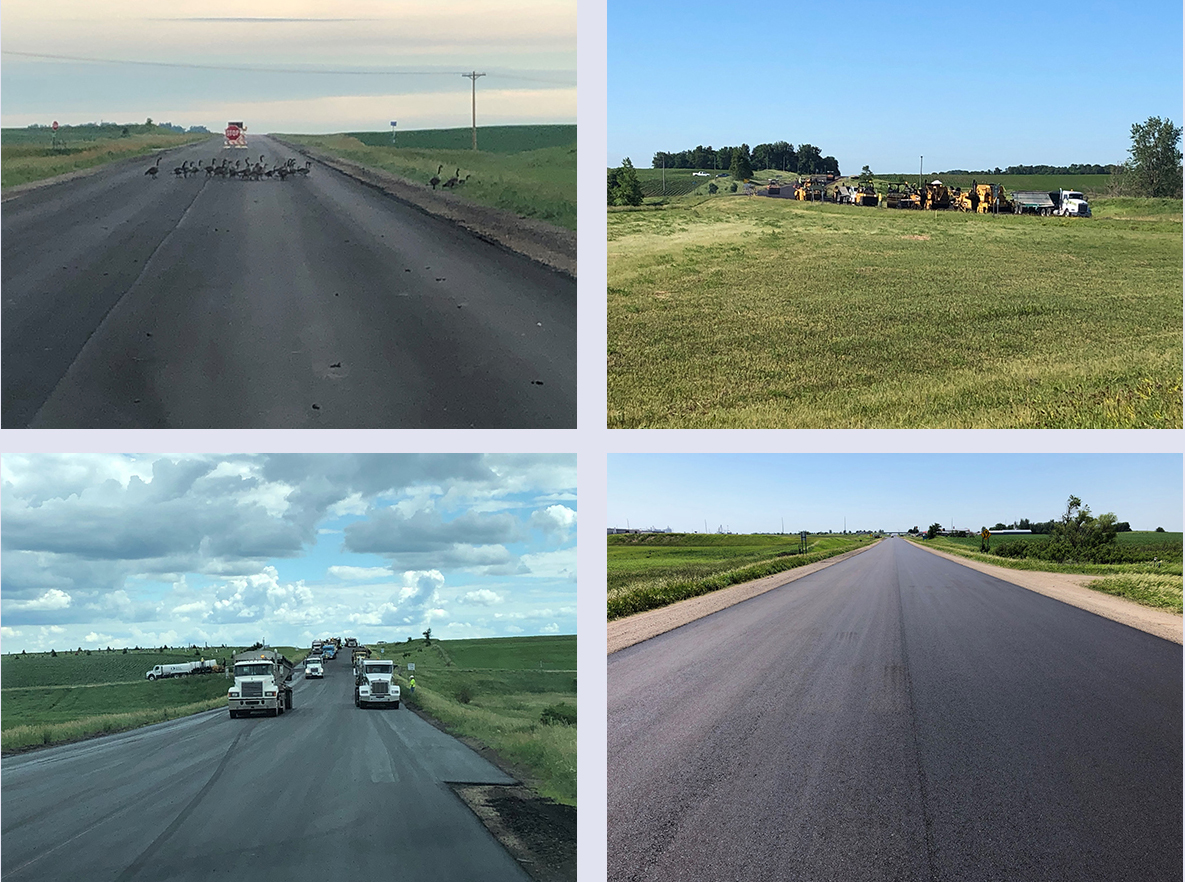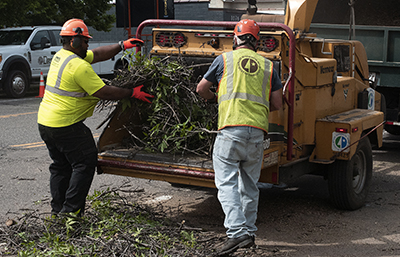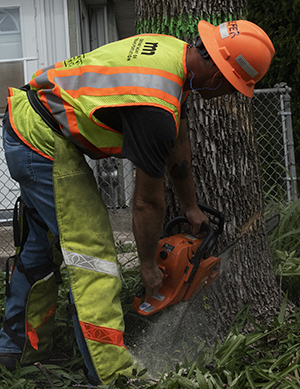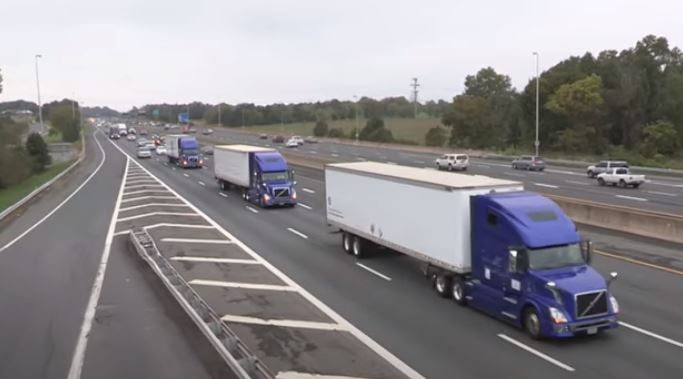 |
|

|
 |
TABLE of CONTENTS
 |
From Governor Walz: Thank you, MnDOT! |
As we continue to find ways to do our jobs and deliver critical services to Minnesotans while adjusting to this “new normal” of social distancing, wearing facial coverings, and other precautions for health and safety, it’s more important than ever to take time to say thanks. This video message from Gov. Tim Walz was shared with all MnDOT employees on Tuesday, July 21. |
|
| |
|

|
 |
TABLE of CONTENTS
 |
Amid quieter workspaces, MnDOT's mission continues |
By Joseph Palmersheim

OFCVO’s Yashica Taylor and Sharon Yekaldo continue to work in the Central Office, decorating their workspace with hearts to remain positive and stay happy. Photo by Judy Jacobs. |
COVID-19 has quieted many formerly bustling places across the world. One of those spots is MnDOT’s Central Office in St. Paul.
On any given pre-pandemic day, thousands of employees would mingle with legislators, other state employees and visitors from all walks of life. Now, the hallways are mostly quiet, the cafeteria stoves have gone cold, and elevators are limited to a certain number of passengers to prevent the virus from spreading.

Yashica Taylor. Submitted photo |
“This has been really different,” said Yashica Taylor, a customer service specialist with the Office of Freight and Commercial Vehicle Operations on CO’s first floor. “I’ve never been through something like this before. It’s scary, because I have to deal with public transportation and the workload is really intense.”
Sharon Yekaldo, who also works in OFCVO, has been with MnDOT for more than 44 years. The customer service specialist describes the office as “very quiet,” which has both pluses and minuses.
“The quiet and not having customers at the counter allowed me to accomplish a lot,” she said. “I miss the camaraderie with my co-workers. Skype meetings just aren’t the same.”
Taylor, Yekaldo and the nearly 60 employees who are still reporting to CO, have not been alone. Approximately 2,700 employees have continued to work from a MnDOT facility since the original directive from the governor in March to have everyone who is able to telework.

Sharon Yekaldo. Submitted photo |
“The way our employees have adapted to these dramatic changes has been very impressive,” said Scott Peterson, deputy commissioner/chief administrative officer. “It has not gone without hiccups, but the transition was remarkably smooth. Although some employees continue to have challenges with their teleworking situation, most have adapted well and are developing a productive rhythm in their work.”
Now, the agency is taking another step in the process of making workplaces safe enough to bring additional employees back. Effective July 15, any MnDOT employee working at a MnDOT facility or in the field, or employees working from home who go to a MnDOT facility, will be required to complete a daily self-assessed health screening. These assessments can be completed online or by phone.
Minnesota Management and Budget asked MnDOT to examine where gaps existed in the agency’s ability to provide service and the service level required to adequately provide those services to the public. As a result, business requirements dictated that some people needed to be returned to the workplace in order to fill those service gaps, Peterson said.
The Returning Employees Safely to the Workplace Steering Team worked with the division business managers, and other managers throughout agency, to identify both the service gaps and the employees who would need to be returned to the workplace in order to provide that service. These employees have been notified by their supervisors.
Peterson said the way MnDOT’s employees have adapted to these dramatic changes “has been very impressive.”
It’s a sentiment echoed by Nancy Daubenberger, deputy commissioner/chief engineer, who said recognition is due to all of the employees who have needed to report to a MnDOT workplace since the beginning of the pandemic.
“We appreciate them for continuing to do so, putting safety protocols in place prior to any official guidance and monitoring their symptoms over the last several months,” Daubenberger said. “As things have progressed with the pandemic, we continue to learn more about COVID-19, and thus we have needed to evolve our practices and procedures. We appreciate our employees’ patience and understanding as we have made changes along way and implemented new tools, to do all we can to protect the health and safety of all our employees during these unprecedented times.”
Until the times are no longer unprecedented, employees like Taylor and Yekaldo will continue to do what they need to do, in person, in spaces which await the hustle and bustle to return.
“I feel strong and brave,” Taylor said. “I’m feeling like I am helping the world, like a superhero would do.”
|
 |
|

|
 |
TABLE of CONTENTS
 |
Hwy 71 sports seamless ride after District 7 project |
By Rebecca Arndt, District 7 Public Affairs

Top left - MnDOT sent out a special request to keep the locals from using Hwy 71 when they did final paving. Looks like they all got the message. Photo by Dan Axford
Top right - It takes a whole train of trucks and machines to complete this dance. Photo by Scott Kern
Bottom left - And a lot of coordination. Photo by Bob Williams
Bottom right - The picture-perfect final product. Look ma! No seams. Photo by Susan Jensen |
More than 30 miles of Hwy 71 in Jackson and Cottonwood counties has been under construction since early May to improve the pavement condition. With one phase of construction complete and the other very nearly complete, it’s technically ahead of schedule.
The 18 miles of pavement work in Jackson County (Jackson County Road 38 to Hwy 60 in Windom) was extensive as MnDOT recycled and repaved the pavement for a longer lasting fix.
This work required numerous steps, including closing the road, detouring traffic and milling off two inches of pavement. Those steps were followed with a cold in-place recycling process that included grinding four inches of pavement, creating a windrow of material, more grinding, mixing with cement, and new oil before it was re-laid on the road.
And that was the easy part. The tricky part was laying two more lifts with the final lift using echelon paving.
“Echelon paving is not easy, it requires more coordination,” said Bob Williams, District 7 resident engineer. “When you have two pavers side by side, you have about 40 trucks following and backing up to the pavers within 5 to 10 minutes of each other. It spreads out about a quarter mile along the highway.”
The Hwy 71 project near Jackson also included the replacement of a large culvert and multiple locations of culvert work.
Resurfacing 12 more miles of Hwy 71 in Cottonwood County (north of Hwy 60 to Hwy 30) was also needed and was completed by milling and overlaying the current pavement along with some culvert work.
Construction Supervisor Robert Sneller and the District 7 construction staff are pleased with the project results that motorists will be able to enjoy for many years to come.
|
| |
|

|
 |
TABLE of CONTENTS
 |
Metro District crews remove infected ash trees |
By Rich Kemp

Dave Jackson and Walt Hodgeman, Metro District tree crew, put branches from an ash tree into a shredder June 15 in St. Paul. Photo by Rich Kemp |
The emerald ash borer species has invaded ash trees in St. Paul, and the Metro District tree crews have launched into action to remove the infected trees. The trees are along Hwy 5 between downtown St. Paul and Interstate 35E.
According to the Minnesota Department of Agriculture, the small, invasive insect infects ash trees and spreads quickly, typically killing a majority of ash trees in its path. Many Minnesota communities have seen the effect of the ash borer as it spreads.
“The St. Paul city forester went through the areas inspecting trees and saw signs of EAB and marked the trees for removal,” said John Sander, Metro District transportation operations supervisor. “There are about 600 trees to be removed.”

Rob Giefer, Metro District tree crew, cuts down an ash tree that was infected with emerald ash borer. Photo by Rich Kemp |
The tree crew is removing trees that are on the MnDOT right of way and the city is removing trees in the same area that are on its roads.
The Arden Hills Truck Station crew, with help from the Maryland Truck Station staff, started removing the trees in early May and have worked on other tree removal projects this summer. There is also a tree crew from the Golden Valley Truck Station.
“It is going pretty well,” said Walt Hodgeman, Arden Hills Truck Station tree crew supervisor. “Our biggest challenges have been the closeness to buildings, power lines, vehicle traffic and road construction.
“Some of the property owners wonder why we are removing the trees,” Hodgeman said. “Once we explain the issue and why we are removing the trees, most of them seem to understand.”
MDA developed this emerald ash borer guide to assist communities in learning how to recognize an EAB infestation. More information on the emerald ash borer can be found on the MDA website.
|
| |
|

|
 |
TABLE of CONTENTS
 |
District 1 mourns loss of Roberta Dwyer |
By Pippi Mayfield, District 1 Public Engagement & Communications

Roberta Dwyer. Submitted photo |
Roberta Dwyer, who oversaw some of the largest, most complex construction projects in District 1, died Tuesday, July 14, one week after retiring and after several years of a hard-fought battle with cancer.
During her 39 years with MnDOT, Dwyer held a variety of engineering and management positions, including maintenance operations engineer, principal project manager and major projects project manager, among others.
Projects she worked on include the final extension of Interstate 35 in Duluth, reconstruction of Hwy 53 segments in Duluth, Hwy 53 relocation project in Virginia, and most recently, the Twin Ports Interchange. Over the years, Dwyer earned respect and built many long-lasting relationships in the engineering community and highway construction industry.
“Roberta had significant capacity to get things done and was dedicated to being a productive MnDOT employee,” said Duane Hill, District 1 engineer. “Roberta had many roles at MnDOT over her career and worked with so many people across the state within and outside of MnDOT who will miss her dearly.”
Hill remembers some of the more significant projects Dwyer was involved in, including the developing a partnership between the city of Duluth, St. Louis County and MnDOT to move MnDOT’s maintenance operations from the Duluth MnDOT Headquarters building to the new St. Louis County facility in Pike Lake; working on development and implementation of the field manual for short-term traffic control; leading the Piedmont Avenue, Trinity Road, Hwy 53 mall area redevelopment; and working on the I-35 Mega project and Twin Ports Interchange projects.
It’s no surprise Dwyer was an integral part of so many projects, according to Pat Huston, assistant district engineer.
“If I had a difficult project, Roberta would be my top draft choice,” Huston said. “She was the hardest-working person I know.”
Dwyer also enjoyed presenting projects to the public – especially to the University for Seniors at the University of Minnesota-Duluth – and was a mentor and advisor to the younger engineers she worked with.
Dwyer and her longtime partner, Dave Clark (who is also a MnDOT retiree), lived in Duluth. Memorial/funeral arrangements are pending.
|
 |
|

|
 |
TABLE of CONTENTS
 |
Minnesota opens pathway for truck platooning tests |
By Anne Meyer

A truck platoon in action, as captured by a Federal Highway Administration video shot near a research center in Virginia. Truck platooning technology allows two or more commercial trucks to travel together at a set, close distance during all or parts of a journey. Submitted photo |
Companies hoping to work with truck platoons in Minnesota now have a clearer path to test this technology thanks to recent changes in state laws and help from a new website from the Connected and Automated Vehicles team.
Truck platooning technology allows two or more commercial trucks to travel together at a set, close distance during all or parts of a journey. State lawmakers passed new vehicle platoon legislation last year to set requirements, including length of platoon, weight limits and prohibited materials. Companies must also submit an operational plan to MnDOT detailing their intended use and plans must receive approval from the Commissioner of Transportation before any truck platoon can hit the road.
Earlier this month, CAV-X launched a new webpage, mndot.gov/truck-platooning, to offer companies the information they need to get their plans approved. The site offers a map of approved highways where truck platoons can operate in Minnesota, a list of new state operational requirements and details about what’s needed to put this technology into motion.
Companies already using truck platoons in other states say the technology helps their business in several ways, including fuel savings, increased range and fewer crashes. Visit MnDOT’s truck platooning website to learn more and watch a U.S. Department of Transportation video to see the technology in action. It demonstrates how truck platooning works in different scenarios and explains why this technology, combined with others, is improving safety on the road.
“We’re excited to work with companies that want to take advantage of truck platooning opportunities in Minnesota,” said Kristin White, CAV-X director. “By working together, we can learn more about this evolving innovation and better plan for advancements in self-driving technologies. Together, we can help Minnesota build a transportation system that is safe, equitable, accessible, efficient and sustainable.”
|
 |
|

|
 |
TABLE of CONTENTS
 |
2019 Sustainability Report summarizes agency progress towards state’s sustainability goals |
By Siri Simons, Principal Sustainability Planner
Transportation is the number one emitter of greenhouse gas emissions in the United States and in Minnesota, something MnDOT has been working hard for several years to mitigate. This week, the agency released its fourth annual Sustainability Report that documents progress MnDOT has made toward its sustainability and climate goals. The report is based on data through 2019.
In 2019, MnDOT collaborated with other state agencies to develop the Pathways to Decarbonizing Transportation Report, which recommends actions to reduce 80 percent of GHG emissions from transportation by 2050. One recommendation was to coordinate with external experts on sustainable transportation and in 2019, MnDOT formed the Sustainable Transportation Advisory Council to present recommendations to Commissioner Margaret Anderson Kelliher to help reduce carbon pollution from transportation.
MnDOT also signed a subscription agreement for 7.4 million kilowatts of community solar energy to save the agency more than $1 million in guaranteed energy costs savings. In addition, MnDOT has increased energy efficiency at its facilities and reduced energy use per square foot 17 percent from 2008 levels.
“This progress would not have been possible without district leadership throughout the agency,” according to Tim Sexton, assistant commissioner and chief sustainability director. (Future Newsline articles will provide more details about sustainability projects happening in MnDOT districts.)
“Transportation is the primary source of carbon pollution in Minnesota and the U.S. and MnDOT is committed to address climate impacts and to work with communities throughout the state to develop a sustainable transportation system of the future,” Sexton said. “The agency has a long-demonstrated history of leadership and innovation that we can leverage to benefit the economy and environment of Minnesota.”
The first MnDOT Sustainability Report in 2016 established a baseline and created measures and targets that agency leaders used to track progress towards achieving sustainability goals listed in the governor’s executive orders, the Next Generation Energy Act and Minn. Statute 174.01. Each report since then has provided updates on the agency's sustainability goals, progress and strategies for achieving the goals.
MnDOT still has a long way to go to reach its sustainability goals, Sexton said.
In 2018, vehicle miles traveled and GHG emissions from the transportation sector increased. MnDOT vehicles generated 16 percent more GHG emissions in 2019 compared to 2018, driven largely by diesel use for snow fighting. The 2019 Sustainability Report outlines the actions staff will take in the future to reverse these trends.
It will take all MnDOT employees to reduce GHG emissions from transportation. Ways to help, particularly for employees not currently teleworking, include:
The 2019 Sustainability Report includes data generated through Dec. 31, 2019, before COVID-19 became a global pandemic.
The 2020 Sustainability Report will address impacts of COVID-19 on agency and state transportation emissions. Contact the Office of Sustainability and Public Health if you have questions or ideas about how MnDOT staff can reduce GHG emissions.
|
 |
|

|
 |
TABLE of CONTENTS
 |
eSAFE now used for workplace injury reporting |
By Joseph Palmersheim
Workplace injury reporting has moved into the digital age.
These reports are now being done through eSAFE, a new process that has replaced traditional paper injury reporting forms. The change went into effect July 13.
“This change will make for less redundancy,” said Sue Kielty, Workers’ Compensation program manager. “Employees no longer need to fill out separate forms, for example, if they were involved in a motor vehicle incident with a work injury, as eSAFE captures what is needed across the two. We can now run our own reports and spot trends more quickly too.”
Here’s how it works: employees must notify their supervisor and/or Workers’ Compensation Coordinator about the work injury immediately and not later than 24 hours after the incident occurred. Supervisors and employees can go to the Workers' Compensation Page and follow the injury process steps, which includes a link for entering the work injury information into eSAFE. A Workers' Compensation Coordinator is available to assist employees who need help.
“The eSAFE process was already being used for other reasons, and the work injury piece is just another component the system can handle and will help keep information better organized,” Kielty said. “It has already provided many benefits to our agency, and we are continuing to expand its capabilities by using the system for all work-related injury reporting.” |
 |
|

|
 |
TABLE of CONTENTS
 |
New drone policy improves speed, efficiency |
By JP Gillach
A new policy aims to streamline aspects of drone operation at MnDOT and clarify responsibilities between operators, districts, contractors and the Office of Aeronautics.
MnDOT’s senior leadership team recently approved revisions to policy OE006 Unmanned Aircraft Systems (previously numbered OP006). The revision process started in August 2019 and involved multiple rounds of stakeholder input.
“We’ve gained a lot of institutional experience in drone operations, and have demonstrated that drones can improve safety for MnDOT employees and the public, improve cost efficiency, and improve data quality,” said Tony Fernando, UAS program administrator, Office of Aeronautics. “We wanted to reflect that new knowledge in our formal policy, and ensure all MnDOT flights are in compliance with state and federal regulations.”
The updated policy streamlines flight plan approvals by allowing the Office of Aeronautics to issue blanket authorizations for flights that will be conducted on a repeating basis, rather than requiring new flight plans and risk assessments on each occasion. The new policy also reduces the number of notifications required for each flight. One added requirement is that districts, offices and consultants must notify tribal nations before flights in Indian Country, reflecting the agency’s responsibilities and improving communications with tribes in Minnesota.
State law requires insurance on aircraft, and the new policy also clarifies that it is the responsibility of the business unit owning a drone to obtain that insurance. Other procedures related to the acquisition of drones by MnDOT business units were slightly modified and remain in place.
One notable streamlining effort centralizes responsibility for a general operating manual from individual MnDOT units, to MnDOT’s Office of Aeronautics. Previously, each unit operating drones maintained separate versions. Business units operating a drone must still produce an aircraft manual specific to the make and model being operated within their unit. Units, such as the Bridge Office, which are developing manuals tailored to their operations, may continue to use and refine those manuals.
MnDOT’s drone Shared Services continues to grow
MnDOT business units that want to use a drone but are not ready to operate a drone themselves may still use MnDOT’s UAS Shared Services, which allows the Office of Aeronautics to fly its drones in support of MnDOT projects. Recent UAS Shared Services projects include 3-D modeling of rock faces and video of traffic patterns. One recent innovative use of Aeronautics’ drones involved livestreaming video from drones flown along sidewalks in various towns. The drone video allowed pedestrian/bike scoping walks to continue despite COVID travel restrictions.
For more information on either the revised policy or UAS shared services, contact Katie Gilmore in the Office of Aeronautics.
|
 |
|

|
 |
TABLE of CONTENTS
 |
Staffing updates |
By Joseph Palmersheim

Josh Root. Submitted photo |
Josh Root will serve as assistant office director for the next nine months as part of an ongoing managerial mobility in the Office of Aeronautics. His first day in the new role was Monday, July 13.
Navigation Systems, Safety & Enforcement, and Air Transportation will be reporting to Root in his new role.
The 12-year MnDOT employee previously served in the Office of Chief Counsel, where he was the senior counsel overseeing tort claims, data practices and litigation management. Prior to his time with the agency, Root was in private practice representing business owners.
Root earned a bachelor’s degree in history, politics and education from Cornell College, followed by a J.D. from Drake University Law School.
|
 |
|

|
 |
TABLE of CONTENTS
 |
Tribal-state relations training adapts to COVID-19 challenges |
By Holly Rosendahl

Holly Rosendahl. Submitted photo |
You feel the pounding drum reverberate through your body as the smell of the burning sacred medicines waft through the air, their smoke lifting prayers to the Creator. Eagle feathers shake on the staff carried by veterans as they dance by. Your host, the tribal leader of this sovereign nation, takes the stage to share their gratitude for your visit and their optimism about your future work together. Welcome to Indian Country.
For many state employees, Tribal-State Relations Training is the first time they have knowingly and intentionally set foot on tribal lands. The training is delivered with support and participation by tribal government leadership, staff and tribal members. All 11 tribes in Minnesota have invited state employees to their sovereign nations to shake hands, share meals, and tell success and failure stories of cooperation and conflict with the state.
Participants learn about American Indian governance, sovereignty, culture, history and the modern and traditional ways of life of Indian people. The goal is to promote authentic, respectful relationships between state agencies and American Indian tribes, creating a future where tribal nations are always considered and consulted in Minnesota decision making, policy building and project initiatives that affect Minnesotans - including Indian people.
One of the August 2019 training attendees, noted: “I truly appreciate the Red Lake Nation opening their community to us for this training. They graciously gave us a glimpse of their traditions and life these last two days. Allowing us to be part of this community for a short time had a larger impact and lasting impression than conducting this training in a state facility.”

This photo is from the 2019 training held at Grand Casino Hinckley, owned by the Mille Lacs and Ojibwe. The State Tribal Liaisons Panel includes, from left, Dr. Jane Harstad (Department of Education), Jackie Dionne (Department of Health), Levi Brown (MnDOT) and Jacob Day (Department of Human Services). Submitted photo |
COVID-19 has presented significant challenges to our work and our mission. After exploring various digital options and considering the in-person components of TSRT that add immeasurable value, we made a decision to temporarily shift our focus. We have used this time to create long-requested resources for state employees pertaining to American Indians. We are developing our website to include one-page reference sheets about each tribe, vetted resource lists and FAQs. We encourage you to periodically visit our site to access newly published information.
Pre-pandemic, we were in the in the early stages of creating E-learning courses for state employees to use before and after trainings and for those who are not able to attend TSRT. These E-learning courses will start to launch this summer beginning with “TSRT: Key Concepts and Terms,” followed by “TSRT: Federal Indian Policy-Historical Legacies and Continuing Impacts,” and “Introduction to Indian Country.” We will continue to develop more courses over time.
Despite COVID-19, the work between state agencies and tribal nations in Minnesota continues and TSRT is necessary for this work to be successful. COVID-19 has restricted our onsite trainings for the unforeseeable future and precautions will require us to temporarily move the training online, but because the training is so grounded in culture and place, we will be ready to resume onsite trainings as soon as it is safe to do so.
As we explore virtual options and work to solve logistical considerations, such as internet speed limitations on tribal lands, we will keep the MnDOT community informed as we develop solutions and work toward online trainings.
We are eager to get back to the drum, the smell of sage and sweetgrass, and the warm encirclement of tribal people around Minnesota. We know history can be taught, but being in relationships is when we really start to change and grow.
Holly Rosendahl is based at the University of Minnesota-Duluth. She serves as Tribal-State Relations Training event and program coordinator. TSRT is the official training offered to all state employees. |
 |
|
| |
|



